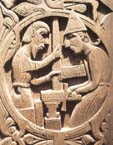 |
 |

Viking Iceland cradle of democracy About the Sagas living literature Vikings in America Project background Publication details Reviews Home |
The SagasA Brief Publication HistoryLIKE SO MANY VENTURES in Icelandic literature, the background to this publication is full of wild idealism and flagrant disregard for apparently insurmountable obstacles. For decades, Icelandic publishers and academics had considered the possibility of translating the entire corpus of the Sagas of Icelanders into English. Nothing happened until the early nineties, when Johann Sigurdsson began to prepare such an edition. Born and brought up on a farm in north Iceland, he read the Sagas as a child and like so many other young Icelanders formed a deep and lasting attachment to the stories of his favourite heroes. In 1993, he founded Leifur Eiriksson Publishing, in partnership with the late Sigurdur Vidar Sigmundsson, for the sole purpose of translating the Sagas into English. An Editorial Board was appointed, comprising Robert Cook, Terry Gunnell, Keneva Kunz and Bernard Scudder, and some translators began work on the longest sagas. Soon it became clear that the organization and funding were heading, like the action of the Sagas, towards epic proportions. In September 1994, Vidar Hreinsson, a Saga scholar with a similar background from a farm in north Iceland, was appointed General Editor. Eventually some 30 translators were brought in on the project, all native speakers of English and experts in Saga literature or professional translators. A network was established on the Internet for fast and effective communication, discussion and feedback by all involved. The Editor and the Editorial Board put extensive work into developing procedures for coordinating key vocabulary, language usage and personal and place names, since one of the distinctive features of the Sagas is that characters and themes recur from one Saga to the next, even though each story is an independent work in its own right. Guidelines and methodologies were also devised for translating the poetry which, due to its peculiar form and imagery, is extremely difficult. As the scope of the project grew, so did the need for funding. Local and international interest gained momentum and the publication received grants from UNESCO, the EC, the Nordic Council, the Government of Iceland and various smaller Icelandic funds, with Icelandair as the main sponsor. The whole project was undertaken in an incredibly short time of four years from first brainwave to final book-binding. With its huge team of translators and a full-time editor, Leifur Eiriksson Publishing feels it has managed to do justice to the original texts without compromising either scholarly integrity or the quality that Icelanders treasure most in their Sagas: readability as modern, living literature. Perhaps this is the largest or most effective project of the kind anywhere else in the world, a coordinated translation of a single literary corpus. The translation has received extremely favourable reviews, for instance in the Times Literary Supplement, Scandinavian Studies, Speculum and the Journal of English and Germanic Philology. Soon after publication it was introduced to the Penguin Press, which showed a keen interest in the work. A contract resulted under which Penguin has just published (March 2000) a large selection of the Sagas in one volume, edited by Ornolfur Thorsson of Leifur Eiriksson Publishing. This edition is to be followed over the next three years by eight more volumes of Sagas in the Penguin Classics series, all based on the Leifur Eiriksson edition. Penguin has assigned editorial responsibility for its entire new Saga series to Leifur Eiriksson Publishing, which regards this recognition from one of the world's leading publishers as a supreme vindication of the philosophy on which Johann Sigurdsson launched his "crazy scheme": delivering good old literature as good modern literature. The President and the Government of Iceland have purchased a number of copies of The Leifur Eiriksson edition and presented them to heads of state and dignitaries on visits and official occasions. Recipients include Pope John Paul II and President Clinton. As part of the Millennium celebrations, the Government of Iceland will be donating 650 sets of the Complete Sagas of Icelanders to public and university libraries in the USA later this year. The sagas are, in fact, the main reason for the close cooperation between the Millennium Committees of the USA and Iceland this year, since they are the only written sources about the Viking discovery of North America in the year 1000.
Leifur Eiriksson Publishing is a tiny company in a tiny country, but perhaps it has accomplished quite a unique achievement, with the aim of bringing the English-speaking world a unique literary heritage in its entirety. The size naturally restricts the ability to win attention outside Iceland, but is actually one of the most remarkable features of the entire venture. |
Explore the World of the Sagas 
"Although the glory of the sagas is indisputable, their literary influence would have been much greater if they had been written in the language of one of the major countries, and we would have regarded the sagas as an anticipation or even as the foundation of the European novel." Milan Kundera Czech novelist 
|
 © 1997 –
Leifur Eiriksson Publishing Ltd.
© 1997 –
Leifur Eiriksson Publishing Ltd.Flokagata 65 – 105 Reykjavik – Iceland Tel: (354) 552-8989 – E-mail: vinland@centrum.is |
||
